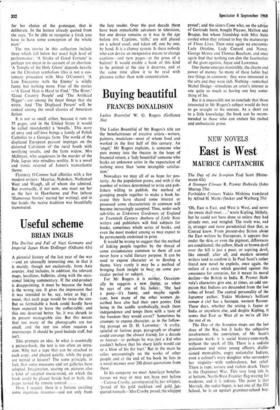The Decline and Fall of Nazi Germany and Imperial Japan
Hans Dollinger (Odhams 63s)
Useful scheme
BRIAN INGLIS
A pictorial history of the last year of the war —and an unusually interesting one, in that it is mainly, though not exclusively, from Axis sources. And includes, in addition, the relevant maps, headlines, bulletins, along with the occa- sional linking commentary. If the end-product is disappointing, it must be because the book is the wrong size. It gives the impression that it was intended to be, say, twice as ,big: :I mean, that each page would be twice the size. But so formidable a book could hardly have been expected to leave the coffee-table; and this one deserved better. So, it was shrunk to its present manageable size. But this means that too many of the photographs are too small, and the text too often requires a microscope. It should be good bedside stuff, but isn't.
This prompts an idea. In what is essentially a picture-book, the text is too often an intru- sion. Why not a tape that can be attached to each copy, and played quietly, while the pages are turned at leisure? The same principle, in fact, that some museums and art galleries have adopted. Imagination, soaring on, pictures also a kind of adapted music-stand, on which the book could be placed beside bed or bath, the pages turned by remote control .
Here, I suspect, there is a fortune awaiting some ingenious inventor—and not only from the lazy reader. Over the past decade there have been remarkable advances in teleVision, but one device remains as it was in the age before rrv. Captions, 'stills,' are still placed on a school easel, and taken off, one by one, by hand. It is a clumsy system. Is there nobody who can devise an inexpensive means to change captions—and turn pages—at the press of a button? It would enable a book of this kind to be printed at the size it deserves, and at the same time allow it to be read with pleasure rather than with concentration.






































 Previous page
Previous page